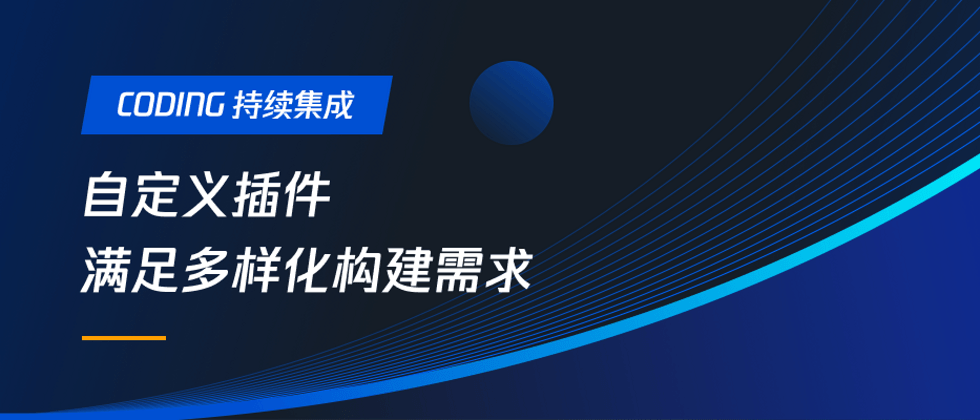Enterprise-level application construction has high requirements for construction speed, code quality, construction performance, ease of use of the pipeline, and ease of maintenance. Enterprise R&D teams usually need to integrate third-party system tools or plug-ins to continuously improve the entire construction process. Efficiency, quality and experience. Based on different management and construction scenario requirements, each team has different requirements for plug-in capabilities.
Recently, CODING continuous integration provides users with more than 10 commonly used official plug-ins. launched a user-defined plug-in capability, allowing team members to encapsulate handy tools or commands into "custom plug-ins", which is convenient for users. Quickly configure the required plug-in capabilities in the build process and support sharing within the team, facilitating quick reuse by other members of the team.
free custom
The custom plug-in does not limit the technology stack and language framework, and any command-line executable program can be packaged into a plug-in. The development team can develop on its own or use open source plug-ins to meet the team's construction needs and meet diversified demands. Upload and use it without official review.
Graphical arrangement
Based on the graphical orchestration capabilities of CODING continuous integration, in the application of the plug-in, you can directly select the plug-in in the process configuration step of the construction, which is simple and easy to use.
Enterprise-level plug-in management capabilities
Custom plug-ins support sharing within the enterprise/team. Team members upload plug-ins can choose to be disclosed to other members of the enterprise, which is conducive to tool sharing among development team members, improves the creativity of developers, and saves the time and energy of repeatedly making wheels.
custom plug-in?
1. View build plugin
Click "Function Settings" → "Continuous Integration" → "Build Plugin" on the left side of the homepage. Here you can see official plugins, team plugins and plugins submitted by individuals but not published. View the name, description and version number in the plug-in details.
2. development plug-in
Plug-in development does not limit the development language and environment, but only needs to meet the plug-in directory structure specification (below) and the specification requirements of the declaration file. When writing your plug-in code, save the logic code to the my-plugin-project/src directory or any subdirectory, and run the entry file to ensure that it is consistent with the declaration file.
Plug-in directory structure:
- my-plugin-project // 您的项目目录
- my-script.xx // 构建插件执行脚本或入口文件,支持任意语言组织(需执行环境具备,如需特殊环境可使用容器)
- qci-plugin.yml // 构建插件声明文件,定义您的构建插件名称、版本、参数等信息
Please click to view the declaration file specification and more detailed development guidelines .
3. upload plugin
After the development is completed, package the plug-in code (zip package) and upload it through "Function Settings" → "Continuous Integration" → "Build Plugin". We will save your project file. When building, the build node will download the project and execute it. After uploading, confirm the release of the plug-in. After release, the members of the public team can be visible.
4. Use plug-ins
You can use the plug-in function in two ways, the graphical layout interface or the compilation command line. When a plug-in is a private plug-in, only the author can add it. When the author marks the plug-in as "public", other members of the team will also be able to see and use the plug-in.
- Graphical arrangement
Click the target "Build Plan" → "Settings" → "Process Configuration", and select whether to enable official plugins or custom plugins of the team when adding steps in the stage.
- Compile command line mode
You can directly edit Jenkinsfile using the command line. Examples of reference statements are as follows:
useCustomStepPlugin(key: 'exec_py_script', version: '1.0', params: [site_packages:'false',requirements:'false'])
// key 为 插件的 ID,version 为版本号(默认使用最新版本,随插件升级而自动升级),params 为当前插件所需要填写的参数。
The "custom plug-in" provided this time expands the construction capability boundary of CODING continuous integration, meets more personalized software construction needs, provides maximum flexibility to the majority of R&D teams, and improves the efficiency of construction process configuration And ease of use . In the future, CODING continuous integration will gradually be compatible with the plug-ins of Drone and GitHub Action, and continue to build the ecological capabilities of CODING continuous integration plug-ins.





**粗体** _斜体_ [链接](http://example.com) `代码` - 列表 > 引用。你还可以使用@来通知其他用户。